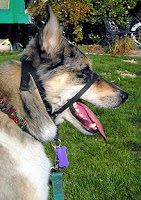Dog Collars
A dog collar is a piece of cloth around the neck of the dog down. A collar can be used for control, identification, fashion, or used for other purposes. Identification tags and medical information is often placed on dog collars. Collars are also useful to control a dog in his hand, because they have to take a grip. The bodies are often used in conjunction with a leash, and a common alternative to a dog collar is a dog harness. Collars are the most common form of directing and teaching dogs.Dog collar is also an unofficial name for the Roman collar of Anglican priests and other clergy uses
Basic collar
On loop leather collar with traditional buckle.
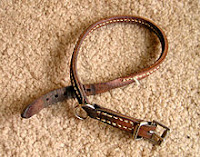 |
| Buckle Collar |
- Buckle collars, also called flat collars are usually made of nylon or leather (rare materials, polyester or metal can be included) with a buckle like a belt buckle, or make a quick release, either stating the collar loosely around the neck of the dog. Can often be identified as a collar, it also comes with an attached loop to which a line can be.
Nylon collar with snap closure with the identification and medical labels bend.
- Flea collars are chemicals, impregnated the fleas. They are usually an additional cuff worn in addition to the conventional loop ring.
- The Elizabethan collar is shaped like a truncated cone may be attached to a dog to keep him from scratching a wound to the head or neck or licking a wound or infection on his body.
- Break-away collars look like necklaces loop, but have installed a security mechanism that rid the dog when the collar allows excessive force is applied. These collars are useful in situations in which hang a number of non-Rapid Release and choke the dog was.
- The safety collar stretch elastic plate in a rugged nylon collar allows escape from the potential dangers of strangulation, such as branches, fences, gates and other dogs. Unlike a stretchable collar looks like a collar to escape traditional static when they cut it with a leash.
- The earrings necklaces blunted leather collars with points and / or metal studs that traditionally prevented another animal from biting the dog's neck attached. In modern societies, stud collars commonly regarded as a fashion accessory.
Training Collar
Several types of clamps are used for training dogs, but sometimes a collar at all (as used in the case of dog agility training, where a collar could get caught on equipment and strangle the dog). Each training collar has its own set of advantages and disadvantages (briefly outlined below), to meet the coach before a SELECT could take. Collars are typically used for training and not on the dog's neck all the time left, as there may be some collar harmful or dangerous if left on an unattended dog.
Flat collar
Some dogs are trained on a leash on a buckle or quick release collar.Choke chains
Chain coils, which specifies how the chain runs through the loop at one end.
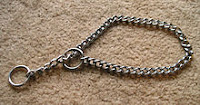 |
| Choke Chain |
Prong Collar
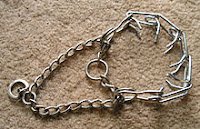 |
| Prong Collar |
Chokers are a series of chain links with blunt ends towards the open neck of the dog turned on. The design of the ring is prong, that they have a limited extent, unlike chain bottlenecks that do not have a limit on how far it is pulling the neck of a dog. The limited pull chain martingale with the angle of the teeth to prevent tooth movement in combination close enough to pinch. The collar is designed for the dog to pull against pressure at any point the dog's neck to prevent.
Choke collars should never be displayed upside down (with the teeth facing away from the skin of the dog) is rotated, as this may result in injury to the body and head. Plastic tips are occasionally form at the ends of the branches of tufts in the protection against or fur down, in the case of the collar low quality products from the rough cut ends chisels, piercing the skin. When the choke chain, collar pin is placed on the neck of the dog's high, just behind the ears, the most sensitive issue.
Some dogs can be of pin necklaces with large wire loop sides shook his head free, so that the links from, so that there are some coaches come to a second collar (usually too large a choke chain) in addition to use of the Necklace Pin Sun if this happens to the dog run loose.
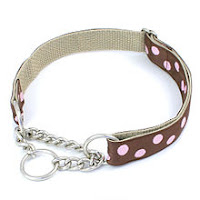 |
| Martingale Collar |
Martingale Collar
Martingale collar with loop chain, martingale collars with a fabric loop instead of string loops and optional on the two styles.Martingale collars are recommended for Sighthounds because their heads are smaller than their necks and they can often slip out of standard collars. However, they can be used for any breed of dog. Their anti-skid function, it has a safety standard in many kennels and animal shelters. A martingale collar has two loops, the smallest circle is the "loop", which attracted the larger loop in dogs to prevent slipping out of the collar tightens. Like a necklace of teeth, the martingale has limited constriction on the dog's neck and applies even pressure.
Head halters
The collar style halter controls the dog's head, but do not limit the ability to pant, drink or objects.Head halters, under the brand names Halti or Gentle Leader or Snoot Loop are sold, are similar in design to a halter for a horse. This unit is on the back of the neck and on top of the snout and gives more control over the direction of a dog and the intensity of the fire on a leash than collars that fit strictly around the neck. The pressure on this type of collar pulls the dog's head to the manager.
Controversy
Proponents of the holster that the manager to control the dog's head, and does not give the dog to stand in a position with its full power. It is particularly useful reagents with dogs, when the control is on the dog's head pose a security problem.Those who do not recommend the use of the halter, that some dogs are natural and uncomfortable. If the collar is too tight it too deep into the skin or the strap around the muzzle may be in the eyes of the dog to push. Head injury is a possible result of an abuse of the halter, if a dog is a sudden jerk of the leash that is attached to the halter, the dog's neck sharply drawn on the page, which could cause injury neck (although this may be true for all necklaces). If the nose strap is mounted too close, the hair is rubbed on the muzzle, too, or the dog's paw and scratches on his face, which range from simple injuries to bare skin to severe abrasion.
Shock Collars
Shock collar (or collars, remote training collars, electric collars, electronic collars and hunting collars) are electronic training aid developed to provide an electrical signal, vibration, sound, deliver, through the contact points on a dog collar. Shock collars are illegal in Wales.Wolf Collar
Collars or protection collars are metal sleeves wolf have large spikes be worn by dogs to protect livestock, if they are attacked by wolves or other predators radiating away from the dog, as a rule. These collars protect the neck of a dog from direct attack. It is rare to see these collars used in modern societies.Force-Collier
The headlock is a leather collar with metal prongs staggered along the inside, like a necklace with three pins.Light Necklace
A necklace of light (or light collar, light dog) is a necklace to make the light, a dog more visible in the darkness to their owners and are mainly the motorists in the vicinity. Note that it does not aim to see a dog in the night, as well documented is that dogs help very good vision in low light conditions.Most chains one or more light emitting diodes for the light source and can be any color, if red and blue, the greatest. Power is provided via one or more batteries, the most common types of its AAA batteries and lithium-key supplied to minimize the extra weight on the collar.
